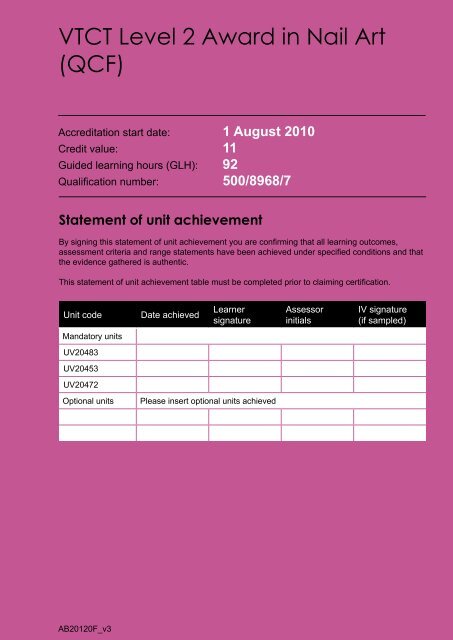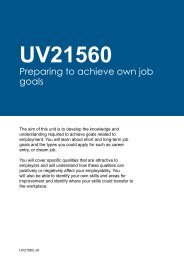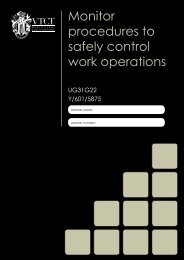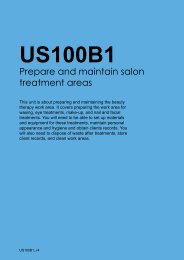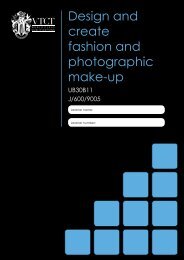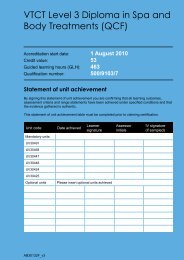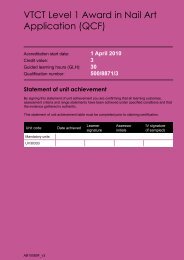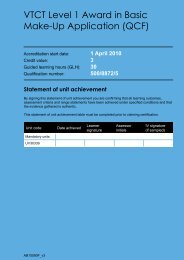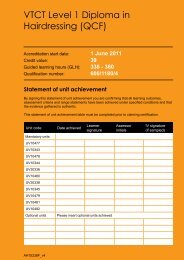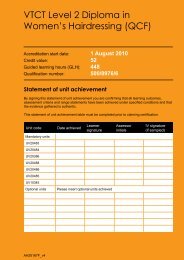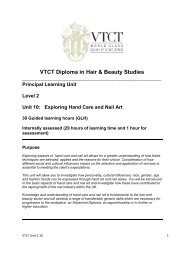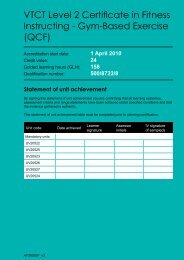VTCT Level 2 Award in Nail Art (QCF)
VTCT Level 2 Award in Nail Art (QCF)
VTCT Level 2 Award in Nail Art (QCF)
You also want an ePaper? Increase the reach of your titles
YUMPU automatically turns print PDFs into web optimized ePapers that Google loves.
<strong>VTCT</strong> <strong>Level</strong> 2 <strong>Award</strong> <strong>in</strong> <strong>Nail</strong> <strong>Art</strong><br />
(<strong>QCF</strong>)<br />
Accreditation start date: 1 August 2010<br />
Credit value:<br />
11<br />
Guided learn<strong>in</strong>g hours (GLH): 92<br />
Qualification number: 500/8968/7<br />
Statement of unit achievement<br />
By sign<strong>in</strong>g this statement of unit achievement you are confirm<strong>in</strong>g that all learn<strong>in</strong>g outcomes,<br />
assessment criteria and range statements have been achieved under specified conditions and that<br />
the evidence gathered is authentic.<br />
This statement of unit achievement table must be completed prior to claim<strong>in</strong>g certification.<br />
Unit code Date achieved<br />
Mandatory units<br />
UV20483<br />
UV20453<br />
UV20472<br />
AB20120F_v3<br />
Learner<br />
signature<br />
Optional units Please <strong>in</strong>sert optional units achieved<br />
Assessor<br />
<strong>in</strong>itials<br />
IV signature<br />
(if sampled)
2<br />
The qualification<br />
Introduction National Occupational Standards (NOS)<br />
The <strong>VTCT</strong> <strong>Level</strong> 2 <strong>Award</strong> <strong>in</strong> <strong>Nail</strong> <strong>Art</strong> (<strong>QCF</strong>) is a<br />
qualification that has been specifically designed<br />
to develop your practical skills <strong>in</strong>; how to provide<br />
nail art.<br />
To further enhance your practical skills you<br />
will have the opportunity to choose from the<br />
follow<strong>in</strong>g practical units; how to provide airbrush<br />
design for nails or how to display retail stock to<br />
promote sales <strong>in</strong> a salon.<br />
Underp<strong>in</strong>n<strong>in</strong>g this qualification you will develop<br />
a sound knowledge of health and safety<br />
practices <strong>in</strong> a salon environment, and how to<br />
promote client care and communications <strong>in</strong><br />
beauty related sectors. You will also develop<br />
an underp<strong>in</strong>n<strong>in</strong>g knowledge and understand<strong>in</strong>g<br />
of the practical skills learned throughout this<br />
qualification.<br />
The purpose of this qualification is to develop<br />
your skills <strong>in</strong> beauty therapy to a high level of<br />
occupational ability, to enable you to perform<br />
your own salon services.<br />
Units <strong>in</strong> this qualification have been mapped<br />
to the relevant NOS (where applicable). This<br />
qualification is accredited on the Qualifications<br />
and Credit Framework (<strong>QCF</strong>).<br />
This qualification is approved and supported by<br />
the Hairdress<strong>in</strong>g and Beauty Industry Authority<br />
(HABIA), the standard sett<strong>in</strong>g body for hair,<br />
beauty, nails and spa qualifications.
Progression<br />
When you have successfully completed this<br />
qualification you will have the opportunity to<br />
progress to the follow<strong>in</strong>g <strong>VTCT</strong> qualifications:<br />
• <strong>Level</strong> 2 NVQ Diploma <strong>in</strong> <strong>Nail</strong> Services<br />
(<strong>QCF</strong>)<br />
Progression opportunities also exist <strong>in</strong> the<br />
form of specialist <strong>VTCT</strong> vocationally related<br />
qualifications:<br />
• <strong>Level</strong> 2 <strong>Award</strong> <strong>in</strong> Salon Reception Duties<br />
(<strong>QCF</strong>)<br />
• <strong>Level</strong> 2 <strong>Award</strong> <strong>in</strong> Airbrush <strong>Nail</strong> Design<br />
(<strong>QCF</strong>)<br />
• <strong>Level</strong> 2 <strong>Award</strong> <strong>in</strong> Mendhi Sk<strong>in</strong> Decoration<br />
(<strong>QCF</strong>)<br />
• <strong>Level</strong> 2 <strong>Award</strong> <strong>in</strong> Ear Pierc<strong>in</strong>g (<strong>QCF</strong>)<br />
• <strong>Level</strong> 2 Certificate <strong>in</strong> <strong>Nail</strong> Treatments<br />
(<strong>QCF</strong>)<br />
• <strong>Level</strong> 2 Certificate <strong>in</strong> <strong>Nail</strong> Technology<br />
(<strong>QCF</strong>)<br />
• <strong>Level</strong> 2 Diploma <strong>in</strong> Beauty Services (<strong>QCF</strong>)<br />
• <strong>Level</strong> 2 Diploma <strong>in</strong> Beauty Specialist<br />
Techniques (<strong>QCF</strong>)<br />
• <strong>Level</strong> 2 Diploma <strong>in</strong> Hair and Beauty<br />
Services (<strong>QCF</strong>)<br />
This qualification may lead directly <strong>in</strong>to<br />
employment <strong>in</strong> the beauty therapy <strong>in</strong>dustry<br />
as a junior beauty therapist <strong>in</strong> a salon or self<br />
employment as a beauty therapist.<br />
3
4<br />
Qualification structure<br />
Total credits required - 11 (m<strong>in</strong>imum)<br />
All mandatory units must be completed.<br />
Mandatory units - 8 credits<br />
<strong>VTCT</strong> unit<br />
code<br />
Ofqual unit<br />
reference<br />
UV20483 R/600/8763<br />
UV20453 A/601/4458<br />
Unit title Credit value GLH<br />
Follow health and safety practice <strong>in</strong> the<br />
salon<br />
Client care and communication <strong>in</strong> beautyrelated<br />
<strong>in</strong>dustries<br />
3 22<br />
2 20<br />
UV20472 L/601/4450 Provide nail art 3 24<br />
Optional units - 3 (m<strong>in</strong>imum) credits<br />
<strong>VTCT</strong> unit<br />
code<br />
Ofqual unit<br />
reference<br />
Unit title Credit value GLH<br />
UV30407 L/601/3931 Airbrush designs for nails 4 22<br />
UV20490 J/600/8761 Display stock to promote sales <strong>in</strong> a salon 3 24
Guidance on assessment<br />
This book conta<strong>in</strong>s the mandatory units that make up this qualification. Optional units will be<br />
provided <strong>in</strong> additional booklets (if applicable). Where <strong>in</strong>dicated, <strong>VTCT</strong> will provide assessment<br />
materials. Assessments may be <strong>in</strong>ternal or external. The method of assessment is <strong>in</strong>dicated <strong>in</strong><br />
each unit.<br />
Internal assessment<br />
(any requirements will be shown <strong>in</strong> the unit)<br />
Assessment is set, marked and <strong>in</strong>ternally<br />
verified by the centre to clearly demonstrate<br />
achievement of the learn<strong>in</strong>g outcomes.<br />
Assessment is sampled by <strong>VTCT</strong> external<br />
verifiers.<br />
External assessment<br />
(any requirements will be shown <strong>in</strong> the unit)<br />
Externally assessed question papers<br />
completed electronically will be set and marked<br />
by <strong>VTCT</strong>.<br />
Externally assessed hard-copy question papers<br />
will be set by <strong>VTCT</strong>, marked by centre staff and<br />
sampled by <strong>VTCT</strong> external verifiers.<br />
Assessment expla<strong>in</strong>ed<br />
<strong>VTCT</strong> courses are assessed and verified by<br />
centre staff. Work will be set to improve your<br />
practical skills, knowledge and understand<strong>in</strong>g.<br />
For practical elements, you will be observed<br />
by your assessor. All your work must be<br />
collected <strong>in</strong> a portfolio of evidence and crossreferenced<br />
to requirements listed <strong>in</strong> this record<br />
of assessment book.<br />
Your centre will have an <strong>in</strong>ternal verifier whose<br />
role is to check that your assessment and<br />
evidence is valid and reliable and meets <strong>VTCT</strong><br />
and regulatory requirements.<br />
An external verifier, appo<strong>in</strong>ted by <strong>VTCT</strong>, will<br />
visit your centre to sample and quality-check<br />
assessments, the <strong>in</strong>ternal verification process<br />
and the evidence gathered. You may be<br />
asked to attend on a different day from usual if<br />
requested by the external verifier.<br />
This record of assessment book is your<br />
property and must be <strong>in</strong> your possession when<br />
you are be<strong>in</strong>g assessed or verified. It must be<br />
kept safe. In some cases your centre will be<br />
required to keep it <strong>in</strong> a secure place. You and<br />
your course assessor will together complete<br />
this book to show achievement of all learn<strong>in</strong>g<br />
outcomes, assessment criteria and ranges.<br />
5
6<br />
Creat<strong>in</strong>g a portfolio of evidence<br />
As part of this qualification you are required to<br />
produce a portfolio of evidence. A portfolio will<br />
confirm the knowledge, understand<strong>in</strong>g and skills<br />
that you have learnt. It may be <strong>in</strong> electronic or<br />
paper format.<br />
Your assessor will provide guidance on how to<br />
prepare the portfolio of evidence and how to<br />
show practical achievement, and understand<strong>in</strong>g<br />
of the knowledge required to successfully<br />
complete this qualification. It is this booklet<br />
along with the portfolio of evidence that will<br />
serve as the prime source of evidence for this<br />
qualification.<br />
Evidence <strong>in</strong> the portfolio may take the follow<strong>in</strong>g<br />
forms:<br />
• Observed work<br />
• Witness statements<br />
• Audio-visual media<br />
• Evidence of prior learn<strong>in</strong>g or atta<strong>in</strong>ment<br />
• Written questions<br />
• Oral questions<br />
• Assignments<br />
• Case studies<br />
All evidence should be documented <strong>in</strong> the<br />
portfolio and cross referenced to unit outcomes.<br />
Construct<strong>in</strong>g the portfolio of evidence should not<br />
be left to the end of the course.<br />
Many frequently asked questions and other<br />
useful <strong>in</strong>formation are detailed <strong>in</strong> the <strong>VTCT</strong><br />
Candidate’s Handbook, which is available on<br />
the <strong>VTCT</strong> website at www.vtct.org.uk/students.<br />
Other questions should be addressed to the<br />
tutor, lecturer or assessor.
Unit assessment methods<br />
This section provides an overview of the assessment methods that make up each unit <strong>in</strong> this<br />
qualification. Detailed <strong>in</strong>formation on assessment is provided <strong>in</strong> each unit.<br />
Mandatory units<br />
<strong>VTCT</strong> unit<br />
code<br />
UV20483<br />
UV20453<br />
Unit title<br />
Follow health and safety practice <strong>in</strong><br />
the salon<br />
Client care and communication <strong>in</strong><br />
beauty-related <strong>in</strong>dustries<br />
External Internal<br />
Question<br />
paper(s)<br />
Observation(s) Assignment(s)<br />
1 � �<br />
0 � �<br />
UV20472 Provide nail art 1 � �<br />
Optional units<br />
<strong>VTCT</strong> unit<br />
code<br />
Unit title<br />
External Internal<br />
Question<br />
paper(s)<br />
Observation(s) Assignment(s)<br />
UV30407 Airbrush designs for nails 0 � �<br />
UV20490<br />
Display stock to promote sales <strong>in</strong> a<br />
salon<br />
0 � �<br />
7
8<br />
Unit glossary<br />
<strong>VTCT</strong> product<br />
code<br />
Description<br />
All units are allocated a unique <strong>VTCT</strong> product code for identification purposes.<br />
This code should be quoted <strong>in</strong> all queries and correspondence to <strong>VTCT</strong>.<br />
Unit title The title clearly <strong>in</strong>dicates the focus of the unit.<br />
National<br />
Occupational<br />
Standards<br />
(NOS)<br />
<strong>Level</strong><br />
Credit value<br />
Guided<br />
learn<strong>in</strong>g hours<br />
(GLH)<br />
Observations<br />
Learn<strong>in</strong>g<br />
outcomes<br />
Evidence<br />
requirements<br />
Maximum<br />
service times<br />
Observation<br />
outcome<br />
Knowledge<br />
outcome<br />
Assessment<br />
criteria<br />
Range<br />
NOS describe the skills, knowledge and understand<strong>in</strong>g needed to undertake a<br />
particular task or job to a nationally recognised level of competence.<br />
<strong>Level</strong> is an <strong>in</strong>dication of the demand of the learn<strong>in</strong>g experience, the depth<br />
and/or complexity of achievement and <strong>in</strong>dependence <strong>in</strong> achiev<strong>in</strong>g the<br />
learn<strong>in</strong>g outcomes. There are 9 levels of achievement with<strong>in</strong> the Qualifications<br />
and Credit Framework (<strong>QCF</strong>).<br />
This is the number of credits awarded upon successful achievement of all unit<br />
outcomes. Credit is a numerical value that represents a means of recognis<strong>in</strong>g,<br />
measur<strong>in</strong>g, valu<strong>in</strong>g and compar<strong>in</strong>g achievement.<br />
GLH is an estimate of the time allocated to teach, <strong>in</strong>struct, assess and<br />
support learners throughout a unit. Learner <strong>in</strong>itiated private study, preparation<br />
and mark<strong>in</strong>g of formative assessment is not taken <strong>in</strong>to account.<br />
This <strong>in</strong>dicates the m<strong>in</strong>imum number of observations required to achieve the<br />
unit.<br />
The learn<strong>in</strong>g outcomes are the most important component of the unit, they set<br />
out what is expected <strong>in</strong> terms of know<strong>in</strong>g, understand<strong>in</strong>g and practical<br />
ability as a result of the learn<strong>in</strong>g process. Learn<strong>in</strong>g outcomes are the results<br />
of learn<strong>in</strong>g.<br />
This section provides guidel<strong>in</strong>es on how evidence must be gathered.<br />
The maximum time <strong>in</strong> which a particular service or practical element must be<br />
completed.<br />
An observation outcome details the practical tasks that must be completed to<br />
achieve the unit.<br />
A knowledge outcome details the theoretical requirements of a unit that must<br />
be evidenced through oral question<strong>in</strong>g, a mandatory written question paper or<br />
portfolio of evidence.<br />
Assessment criteria set out what is required, <strong>in</strong> terms of achievement, to meet<br />
a learn<strong>in</strong>g outcome. The assessment criteria and learn<strong>in</strong>g outcomes are the<br />
components that <strong>in</strong>form the learn<strong>in</strong>g and assessment that should take place.<br />
Assessment criteria def<strong>in</strong>e the standard expected to meet learn<strong>in</strong>g outcomes.<br />
The range <strong>in</strong>dicates what must be covered. Ranges must be practically<br />
demonstrated <strong>in</strong> parallel to the unit’s observation outcomes.
UV20483<br />
Follow health and safety<br />
practice <strong>in</strong> the salon<br />
The aim of this unit is to <strong>in</strong>crease your understand<strong>in</strong>g of<br />
health and safety and its importance <strong>in</strong> the salon <strong>in</strong> which<br />
you work.<br />
You will develop the ability to carry out a simple risk<br />
analysis, recognise a hazard, responsibly deal with the<br />
hazards you have found and follow safe and hygienic<br />
work<strong>in</strong>g practices.<br />
You will also need to be able to locate fire fight<strong>in</strong>g<br />
equipment, first aid resources and have an awareness of<br />
fire, emergency and evacuation procedures.<br />
This unit applies to hairdress<strong>in</strong>g, beauty therapy, nail and<br />
barber<strong>in</strong>g salons and spas.<br />
UV20483_v7
<strong>Level</strong><br />
Credit value<br />
GLH<br />
2<br />
3<br />
22<br />
Observation(s)<br />
3<br />
External paper(s)<br />
1
Follow health and safety<br />
practice <strong>in</strong> the salon<br />
Learn<strong>in</strong>g outcomes Evidence requirements<br />
On completion of this unit you will:<br />
1. Be able to ma<strong>in</strong>ta<strong>in</strong> health, safety and<br />
security practices<br />
2. Be able to follow emergency procedures<br />
1. Environment<br />
Evidence for this unit must be gathered <strong>in</strong> a<br />
real or realistic work<strong>in</strong>g environment.<br />
2. Simulation<br />
Simulation is not allowed <strong>in</strong> this unit.<br />
3. Observation outcomes<br />
Competent performance of ‘Observation’<br />
outcomes must be demonstrated to your<br />
assessor on at least three occasions.<br />
4. Knowledge outcomes<br />
There must be evidence that you possess<br />
all the knowledge and understand<strong>in</strong>g<br />
listed <strong>in</strong> the ‘Knowledge’ section of this<br />
unit. This evidence may <strong>in</strong>clude projects,<br />
assignments, case studies, reflective<br />
accounts, oral/written question<strong>in</strong>g and/or<br />
other forms of evidence.<br />
5. Tutor/Assessor guidance<br />
You will be guided by your tutor/assessor<br />
on how to achieve learn<strong>in</strong>g outcomes <strong>in</strong> this<br />
unit. All outcomes must be achieved.<br />
6. External paper<br />
Knowledge and understand<strong>in</strong>g <strong>in</strong> this unit<br />
will be assessed by an external paper.<br />
The criteria that make up this paper are<br />
highlighted <strong>in</strong> white throughout this unit.<br />
There is one external paper that must be<br />
achieved.<br />
UV20483<br />
11
12<br />
Achiev<strong>in</strong>g observations<br />
and range<br />
Achiev<strong>in</strong>g observation outcomes<br />
Your assessor will observe your performance<br />
of practical tasks. The m<strong>in</strong>imum number<br />
of observations required is <strong>in</strong>dicated <strong>in</strong> the<br />
evidence requirements section of this unit.<br />
Criteria may not always naturally occur dur<strong>in</strong>g<br />
a practical observation. In such <strong>in</strong>stances you<br />
will be asked questions to demonstrate your<br />
competence <strong>in</strong> this area. Your assessor will<br />
document the criteria that have been achieved<br />
through oral question<strong>in</strong>g.<br />
Your assessor will sign off an outcome when all<br />
criteria have been competently achieved <strong>in</strong> a<br />
s<strong>in</strong>gle client service.<br />
Achiev<strong>in</strong>g range<br />
There are no range statements that apply to this<br />
unit.<br />
UV20483<br />
Maximum service times<br />
There are no maximum service times that apply<br />
to this unit.
Outcome 1<br />
You can:<br />
a. Conduct yourself <strong>in</strong> the workplace to meet<br />
with health and safety practices and salon<br />
policy<br />
b. Deal with hazards with<strong>in</strong> your own area of<br />
responsibility follow<strong>in</strong>g salon policy<br />
c. Ma<strong>in</strong>ta<strong>in</strong> a level of personal presentation,<br />
hygiene and conduct to meet with legal and<br />
salon requirements<br />
d. Follow salon policy for security<br />
e. Make sure tools, equipment, materials, and<br />
work areas meet hygiene requirements<br />
*May be assessed through oral question<strong>in</strong>g.<br />
Observations<br />
Be able to ma<strong>in</strong>ta<strong>in</strong> health, safety and security practices<br />
f. Use required personal protective equipment<br />
g. Position yourself and the client safely<br />
h. Handle, use, and store products, materials,<br />
tools, and equipment safely to meet with<br />
manufacturer’s <strong>in</strong>structions<br />
i. Dispose of all types of salon waste<br />
safely and to meet with legal and salon<br />
requirements<br />
Observation 1 2 3<br />
Date achieved<br />
Criteria questioned orally<br />
Portfolio reference<br />
Assessor <strong>in</strong>itials<br />
Learner signature<br />
UV20483 13
14<br />
© Habia<br />
Outcome 2<br />
Be able to follow emergency procedures<br />
You can:<br />
a. Follow emergency procedures<br />
b. Follow accident report<strong>in</strong>g procedures which<br />
meet with salon policy<br />
c. Locate fire fight<strong>in</strong>g equipment<br />
*May be assessed through oral question<strong>in</strong>g.<br />
Observation<br />
Date achieved<br />
Criteria questioned orally<br />
Portfolio reference<br />
Assessor <strong>in</strong>itials<br />
Learner signature<br />
1 Optional Optional<br />
UV20483
Achiev<strong>in</strong>g knowledge outcomes<br />
You will be guided by your tutor and assessor<br />
on the evidence that needs to be produced.<br />
Your knowledge and understand<strong>in</strong>g will be<br />
assessed us<strong>in</strong>g the assessment methods listed<br />
below:<br />
• Observed work<br />
• Witness statements<br />
• Audio-visual media<br />
• Evidence of prior learn<strong>in</strong>g or atta<strong>in</strong>ment<br />
• Written questions<br />
• Oral questions<br />
• Assignments<br />
• Case studies<br />
Achiev<strong>in</strong>g the external paper<br />
Develop<strong>in</strong>g knowledge<br />
Where possible your assessor will <strong>in</strong>tegrate<br />
knowledge outcomes <strong>in</strong>to practical observations<br />
through oral question<strong>in</strong>g.<br />
The external paper will test your knowledge of the criteria highlighted <strong>in</strong> white. A pass mark of<br />
70% must be achieved. Criteria not achieved will be identified to your tutor/assessor. You will then<br />
be orally questioned or asked to produce other forms of evidence as all unit criteria must<br />
be achieved.<br />
Your assessor will complete the follow<strong>in</strong>g table when the 70% pass mark has been achieved.<br />
Paper Date achieved Assessor <strong>in</strong>itials<br />
1 of 1<br />
UV20483 15
16<br />
Knowledge<br />
Outcome 1<br />
Be able to ma<strong>in</strong>ta<strong>in</strong> health, safety and security practices<br />
You can:<br />
j. Expla<strong>in</strong> the difference between legislation, codes of practice and<br />
workplace policies<br />
k. Outl<strong>in</strong>e the ma<strong>in</strong> provisions of health and safety legislation<br />
l. State the employer’s and employee’s health and safety<br />
responsibilities<br />
m. State the difference between a ‘hazard’ and a ‘risk’<br />
n. Describe hazards that may occur <strong>in</strong> a salon<br />
o. State the hazards which need to be referred<br />
p. State the purpose of personal protective equipment used <strong>in</strong> a<br />
salon dur<strong>in</strong>g different services<br />
q. State the importance of personal presentation, hygiene, and<br />
conduct <strong>in</strong> ma<strong>in</strong>ta<strong>in</strong><strong>in</strong>g health and safety <strong>in</strong> the salon<br />
r. State the importance of ma<strong>in</strong>ta<strong>in</strong><strong>in</strong>g the security of belong<strong>in</strong>gs<br />
s. Outl<strong>in</strong>e the pr<strong>in</strong>ciples of hygiene and <strong>in</strong>fection control<br />
t. Describe the methods used <strong>in</strong> the salon to ensure hygiene<br />
u. Describe the effectiveness and limitations of different <strong>in</strong>fection<br />
control techniques<br />
v. Describe how to dispose of different types of salon waste<br />
*Assessor <strong>in</strong>itials to be <strong>in</strong>serted if orally questioned.<br />
Requirements highlighted <strong>in</strong> white are assessed <strong>in</strong> the external paper.<br />
UV20483<br />
Portfolio reference /<br />
Assessor <strong>in</strong>itials*
Outcome 2<br />
Be able to follow emergency procedures<br />
You can:<br />
d. Identify named emergency personnel<br />
e. Describe procedures for deal<strong>in</strong>g with emergencies<br />
f. Outl<strong>in</strong>e the correct use of fire fight<strong>in</strong>g equipment for different types<br />
of fire<br />
g. State the dangers of the <strong>in</strong>correct use of fire fight<strong>in</strong>g equipment on<br />
different types of fires<br />
h. State the importance for report<strong>in</strong>g and record<strong>in</strong>g accidents<br />
i. Describe the procedure for report<strong>in</strong>g and record<strong>in</strong>g accidents<br />
*Assessor <strong>in</strong>itials to be <strong>in</strong>serted if orally questioned.<br />
Requirements highlighted <strong>in</strong> white are assessed <strong>in</strong> the external paper.<br />
Portfolio reference /<br />
Assessor <strong>in</strong>itials*<br />
© Habia<br />
UV20483 17
18<br />
Unit content<br />
This section provides guidance on the recommended knowledge and skills required to enable you<br />
to achieve each of the learn<strong>in</strong>g outcomes <strong>in</strong> this unit. Your tutor/assessor will ensure you have the<br />
opportunity to cover all of the unit content.<br />
Outcome 1: Be able to ma<strong>in</strong>ta<strong>in</strong> health, safety and security practices<br />
Hazards and risks: A hazard is someth<strong>in</strong>g<br />
that has the potential to cause harm. A risk<br />
is the likelihood of a hazard happen<strong>in</strong>g.<br />
Salon hazards: Require immediate<br />
action – refer to job description, level of<br />
responsibility, report, duty to recognise/<br />
deal with hazards, tra<strong>in</strong><strong>in</strong>g on deal<strong>in</strong>g<br />
with hazards, deal with hazards without<br />
endanger<strong>in</strong>g self/others, if <strong>in</strong> doubt call for<br />
assistance, nom<strong>in</strong>ated personnel, duty to<br />
recognise/deal with hazards.<br />
Environmental – wet/slippery floor,<br />
cluttered passage/corridors, rearrange<br />
furniture, blocked passageway/entrance/<br />
exit.<br />
Equipment – broken, worn, faulty,<br />
<strong>in</strong>correct use.<br />
Chemicals – leak<strong>in</strong>g, damaged packag<strong>in</strong>g.<br />
Security (cash) – unattended reception/till,<br />
money <strong>in</strong> transit, cash left <strong>in</strong> till overnight.<br />
Security (people) – staff, clients, visitors,<br />
children, personal belong<strong>in</strong>gs, disregard of<br />
systems (security, emergency evacuation,<br />
storage/use of confidential staff/client<br />
records, bus<strong>in</strong>ess <strong>in</strong>formation).<br />
Hygiene – poor personal cleanl<strong>in</strong>ess, lack<br />
of regular wash<strong>in</strong>g of uniform, equipment<br />
(dirty, not sterilised, cross-<strong>in</strong>fection,<br />
cross-contam<strong>in</strong>ation between clients.<br />
Salon policy for security:<br />
Cash – staff tra<strong>in</strong><strong>in</strong>g, po<strong>in</strong>t of sale, regular<br />
bank<strong>in</strong>g, <strong>in</strong> transit.<br />
UV20483<br />
People – staff, clients, visitors, children,<br />
personal belong<strong>in</strong>gs, systems (security,<br />
emergency evacuation, storage/use of<br />
confidential staff/client records, bus<strong>in</strong>ess<br />
<strong>in</strong>formation).<br />
Belong<strong>in</strong>gs – client to reta<strong>in</strong> personal<br />
belong<strong>in</strong>gs where possible, empty pockets<br />
prior to hang<strong>in</strong>g coat, staff belong<strong>in</strong>gs to<br />
rema<strong>in</strong> <strong>in</strong> staff room, avoid personal items<br />
<strong>in</strong> salon.<br />
Security breaches – <strong>in</strong>form salon owner/<br />
head of school, review records (stock<br />
levels/control, monitor tak<strong>in</strong>gs, <strong>in</strong>ventory<br />
of equipment, manual and computerised<br />
records), take statements, eye witness<br />
accounts, review f<strong>in</strong>d<strong>in</strong>gs, call <strong>in</strong> police,<br />
notify data protection registry/clients of<br />
breach, ma<strong>in</strong>ta<strong>in</strong> confidentiality, could<br />
result <strong>in</strong> loss of employment.<br />
Use of tools and equipment: Comply with<br />
legislation, health and safety, electricity at<br />
work, portable appliance test<strong>in</strong>g, report<strong>in</strong>g<br />
of <strong>in</strong>juries and dangerous diseases,<br />
manual handl<strong>in</strong>g, visual checks, only use<br />
for <strong>in</strong>tended purpose, no trail<strong>in</strong>g wires,<br />
manufacturer’s <strong>in</strong>structions, fit for purpose.<br />
Ma<strong>in</strong>tenance of tools and equipment:<br />
Equipment and tools cleaned, washed,<br />
appropriate sterilisation (barbicide,<br />
autoclave, UV, sterilis<strong>in</strong>g spray), complete<br />
destruction of all liv<strong>in</strong>g organisms on tools<br />
and equipment, dis<strong>in</strong>fection (remove<br />
contam<strong>in</strong>ation from hard surfaces), heat or<br />
chemical methods, visual check, remove
Outcome 1: Be able to ma<strong>in</strong>ta<strong>in</strong> health, safety and security practices (cont<strong>in</strong>ued)<br />
and label broken tools and equipment,<br />
store correctly.<br />
Preparation of work area: Work station/<br />
bed/chair/trolley, equipment cleaned,<br />
appropriate sterilisation (barbicide,<br />
autoclave, UV, sterilis<strong>in</strong>g spray), complete<br />
destruction of all liv<strong>in</strong>g organisms on tools<br />
and equipment, dis<strong>in</strong>fection (remove<br />
contam<strong>in</strong>ation from hard surfaces, large<br />
work areas, floors and work surfaces),<br />
heat or chemical methods, bactericides,<br />
fungicides, viricides, full access around<br />
work area, safe professional presentation<br />
tools and equipment, visual check on large/<br />
small equipment, portable appliance tested,<br />
bed/seat/bas<strong>in</strong> (select height).<br />
How to follow safe and hygienic work<strong>in</strong>g<br />
practices:<br />
Ma<strong>in</strong>ta<strong>in</strong><strong>in</strong>g a safe salon – all staff to<br />
adhere to salon policies, clean, tidy, safe<br />
standards of work<strong>in</strong>g, remove spillages,<br />
report slippery surfaces, remove/report<br />
obstacles, clear access to work stations/<br />
beds/trolleys and equipment, clean/<br />
sterilise/dis<strong>in</strong>fect tools, equipment and<br />
work surfaces, risk assessment, no<br />
smok<strong>in</strong>g, eat<strong>in</strong>g, dr<strong>in</strong>k<strong>in</strong>g or drugs <strong>in</strong> salon,<br />
professional personal hygiene.<br />
Personal protective equipment – avoid<br />
latex, powdered gloves, apron, protective<br />
glasses.<br />
Electricity at work – visual check of<br />
equipment, no trail<strong>in</strong>g wires, portable<br />
appliance test<strong>in</strong>g.<br />
Manual handl<strong>in</strong>g – mov<strong>in</strong>g stock safely,<br />
lift<strong>in</strong>g, work<strong>in</strong>g heights, unpack<strong>in</strong>g.<br />
Towels – clean for every client, place dirty<br />
towels <strong>in</strong> covered b<strong>in</strong>.<br />
Report<strong>in</strong>g of <strong>in</strong>juries diseases and<br />
dangerous occurrences – accident book,<br />
report<strong>in</strong>g diseases, log accidents.<br />
Control of substances hazardous to<br />
health – store, handle, use, disposal,<br />
replace lids, ventilation for vapour and dust,<br />
avoid over exposure to chemicals, use<br />
manufacturer’s <strong>in</strong>structions for use.<br />
Disposal of waste – sharps box, closed<br />
top b<strong>in</strong>, dilute chemicals with runn<strong>in</strong>g water,<br />
environmental protection, salon policies for<br />
hazardous waste, s<strong>in</strong>gle use items, recycle<br />
empties.<br />
Behave professionally <strong>in</strong> a salon<br />
environment: Follow health and safety<br />
practices and procedures, follow salon<br />
code of conduct, respect and co-operate<br />
with others (team work – be sympathetic,<br />
fair, not aggressive), avoid gossip, value<br />
client(s), use appropriate language,<br />
ma<strong>in</strong>ta<strong>in</strong> confidentiality, uphold a polite,<br />
cheerful and friendly manner (friendly facial<br />
expressions, open body language, positive<br />
attitude), eye contact, sensible behaviour,<br />
take pride <strong>in</strong> work, be punctual, employer<br />
and client loyalty.<br />
How to ma<strong>in</strong>ta<strong>in</strong> personal presentation<br />
and hygiene: Clothes/uniform (washed/<br />
ironed daily), hair (clean, healthy,<br />
manageable, off face), personal hygiene<br />
(shower daily, clean teeth, fresh breath<br />
deodorant, avoid overpower<strong>in</strong>g perfume/<br />
aftershave), workable length clean nails<br />
(hair), short clean nails (beauty), m<strong>in</strong>imal<br />
jewellery/no jewellery, light fresh make-up,<br />
comfortable clean shoes, wash hands<br />
between clients, cover cuts and wounds<br />
© Habia<br />
UV20483 19
20<br />
© Habia<br />
Outcome 1: Be able to ma<strong>in</strong>ta<strong>in</strong> health, safety and security practices (cont<strong>in</strong>ued)<br />
with plaster, wear personal protective<br />
equipment.<br />
Risk: The likelihood of a hazard<br />
happen<strong>in</strong>g, risk assessment, determ<strong>in</strong>e the<br />
level of risk, preventative measures, reduce<br />
a potentially harmful situation, judgement<br />
of salon hazards, who/what/level of risk,<br />
<strong>in</strong>terpret results, conclusions, record<br />
f<strong>in</strong>d<strong>in</strong>gs, regular reviews.<br />
Position yourself and the client<br />
appropriately:<br />
Stylist/therapist/nail technician – position<br />
self safely, when you sit or stand ensure<br />
good posture (straight back, stand upright,<br />
even weight distribution, ma<strong>in</strong>ta<strong>in</strong> balance,<br />
rema<strong>in</strong> relaxed, don’t overstretch), poor<br />
posture will result <strong>in</strong> fatigue, uneven<br />
service, back/shoulder <strong>in</strong>jury.<br />
Client – seated/laid comfortably (adjust<br />
height of chair, adjust back rest of bed),<br />
if seated keep feet flat on floor, legs<br />
uncrossed, back supported, regular comfort<br />
breaks.<br />
The difference between health and<br />
safety legislation, regulations and code<br />
of conduct:<br />
Legislation and regulations –<br />
government lead, implemented, monitored.<br />
Code of practice and policies – salon<br />
lead, implemented, monitored.<br />
Salon health and safety legislation<br />
and regulations: Health and safety at<br />
work, control of substances hazardous<br />
to health, report<strong>in</strong>g of <strong>in</strong>juries diseases<br />
and dangerous occurrences, personal<br />
protective equipment, electricity at work,<br />
manual handl<strong>in</strong>g, supply of goods and<br />
UV20483<br />
services, trade description, data protection,<br />
employer’s liability (compulsory <strong>in</strong>surance),<br />
occupier’s liability, local by-laws (set by<br />
council), salon rules, code of conduct,<br />
observance by all staff.<br />
Employer responsibility for safety of<br />
staff/employees/clients: Hold current/<br />
valid liability <strong>in</strong>surance, display health and<br />
safety rules cover<strong>in</strong>g staff/employees/<br />
clients/fire evacuation, provide regular<br />
tra<strong>in</strong><strong>in</strong>g, accurate record keep<strong>in</strong>g,<br />
monitor<strong>in</strong>g, consult experts.
Outcome 2: Be able to follow emergency procedures<br />
Emergency procedures:<br />
Accidents – call ambulance, <strong>in</strong>ternal<br />
emergency number, nom<strong>in</strong>ated first aider,<br />
records.<br />
First aid – call nom<strong>in</strong>ated first aider,<br />
emergency <strong>in</strong>ternal number, ensure<br />
accurate records.<br />
First aid equipment – first aid box(es),<br />
list of equipment, general advice leaflet,<br />
various sized dress<strong>in</strong>gs, eye pad, eye bath,<br />
triangular bandages, safety p<strong>in</strong>s, antiseptic<br />
cream, medical wipes, sterile gloves, sterile<br />
water, cotton wool.<br />
Fire evacuation – nom<strong>in</strong>ated assembly<br />
po<strong>in</strong>t, fire wardens, regular simulation.<br />
Incidents – call security, emergency<br />
<strong>in</strong>ternal number, emergency external<br />
numbers 999 (UK) or 112 (EU).<br />
Position of fire fight<strong>in</strong>g equipment –<br />
<strong>in</strong>duction process.<br />
How to use fire fight<strong>in</strong>g equipment<br />
– designated personnel, <strong>in</strong>itial/ongo<strong>in</strong>g<br />
tra<strong>in</strong><strong>in</strong>g.<br />
Records and documentation – <strong>in</strong>itial/<br />
ongo<strong>in</strong>g tra<strong>in</strong><strong>in</strong>g, up-to-date, accurate.<br />
Safety drills – <strong>in</strong>duction process, <strong>in</strong>itial/<br />
ongo<strong>in</strong>g tra<strong>in</strong><strong>in</strong>g person, regular simulation.<br />
Personnel responsible for safety –<br />
nom<strong>in</strong>ated health and safety officer<br />
(<strong>in</strong>ternal/external).<br />
Fire fight<strong>in</strong>g equipment: Location,<br />
ext<strong>in</strong>guishers (water, foam, powder, CO 2<br />
gas), sand bucket, fire blanket, alarm.<br />
Incorrect use of fire fight<strong>in</strong>g equipment:<br />
Fire could deteriorate/uncontrollable,<br />
<strong>in</strong>jury to personnel, damage to belong<strong>in</strong>gs/<br />
property.<br />
© Habia<br />
UV20483 21
22<br />
UV20483<br />
Notes<br />
Use this area for notes and diagrams
UV20453<br />
Client care and communication<br />
<strong>in</strong> beauty-related <strong>in</strong>dustries<br />
This unit is about client care and communication<br />
<strong>in</strong> beauty-related <strong>in</strong>dustries. You will develop your<br />
communication skills to deal with consultations, compla<strong>in</strong>ts,<br />
client comfort and all forms of client care. You will develop<br />
a client-centred approach to all your treatments.<br />
UV20453_v4
<strong>Level</strong><br />
Credit value<br />
GLH<br />
2<br />
2<br />
20<br />
Observation(s)<br />
3<br />
External paper(s)<br />
0
Client care and communication<br />
<strong>in</strong> beauty-related <strong>in</strong>dustries<br />
Learn<strong>in</strong>g outcomes Evidence requirements<br />
On completion of this unit you will:<br />
1. Be able to communicate with clients<br />
2. Be able to provide client care<br />
1. Environment<br />
Evidence for this unit must be gathered <strong>in</strong> a<br />
real or realistic work<strong>in</strong>g environment.<br />
2. Simulation<br />
Simulation is not allowed <strong>in</strong> this unit.<br />
3. Observation outcomes<br />
Competent performance of ‘Observation’<br />
outcomes must be demonstrated to your<br />
assessor on at least three occasions.<br />
4. Range<br />
All ranges must be practically demonstrated<br />
or other forms of evidence produced to<br />
show they have been covered.<br />
5. Knowledge outcomes<br />
There must be evidence that you possess<br />
all the knowledge and understand<strong>in</strong>g<br />
listed <strong>in</strong> the ‘Knowledge’ section of this<br />
unit. This evidence may <strong>in</strong>clude projects,<br />
assignments, case studies, reflective<br />
accounts, oral/written question<strong>in</strong>g and/or<br />
other forms of evidence.<br />
6. Tutor/Assessor guidance<br />
You will be guided by your tutor/assessor<br />
on how to achieve learn<strong>in</strong>g outcomes and<br />
ranges <strong>in</strong> this unit. All outcomes and ranges<br />
must be achieved.<br />
7. External paper<br />
There is no external paper requirement for<br />
this unit.<br />
UV20453<br />
25
26<br />
Achiev<strong>in</strong>g observations<br />
and range<br />
Achiev<strong>in</strong>g observation outcomes<br />
Your assessor will observe your performance<br />
of practical tasks. The m<strong>in</strong>imum number<br />
of observations required is <strong>in</strong>dicated <strong>in</strong> the<br />
evidence requirements section of this unit.<br />
Criteria may not always naturally occur dur<strong>in</strong>g<br />
a practical observation. In such <strong>in</strong>stances you<br />
will be asked questions to demonstrate your<br />
competence <strong>in</strong> this area. Your assessor will<br />
document the criteria that have been achieved<br />
through oral question<strong>in</strong>g.<br />
Your assessor will sign off an outcome when all<br />
criteria have been competently achieved <strong>in</strong> a<br />
s<strong>in</strong>gle client service.<br />
Achiev<strong>in</strong>g range<br />
The range section <strong>in</strong>dicates what must<br />
be covered. Ranges should be practically<br />
demonstrated as part of an observation. Where<br />
this is not possible other forms of evidence may<br />
be produced. All ranges must be covered.<br />
Your assessor will document the portfolio<br />
reference once a range has been competently<br />
achieved.<br />
UV20453<br />
Maximum service times<br />
There are no maximum service times that apply<br />
to this unit.
Outcome 1<br />
Be able to communicate with clients<br />
You can:<br />
a. Use effective communication techniques<br />
b. Use client consultation techniques to<br />
identify treatment objectives<br />
c. Provide the client with clear advice and<br />
recommendations<br />
*May be assessed through oral question<strong>in</strong>g.<br />
Observations<br />
Observation 1 2 3<br />
Date achieved<br />
Criteria questioned orally<br />
Portfolio reference<br />
Assessor <strong>in</strong>itials<br />
Learner signature<br />
UV20453 27
28<br />
© Habia<br />
Outcome 2<br />
Be able to provide client care<br />
You can:<br />
a. Ma<strong>in</strong>ta<strong>in</strong> client confidentiality <strong>in</strong> accordance<br />
with legislation<br />
b. Ga<strong>in</strong> feedback from clients on client care<br />
c. Respond to feedback <strong>in</strong> a constructive way<br />
d. Refer client compla<strong>in</strong>ts to the relevant<br />
person<br />
e. Assist <strong>in</strong> client compla<strong>in</strong>ts be<strong>in</strong>g resolved<br />
*May be assessed through oral question<strong>in</strong>g.<br />
Observation<br />
Date achieved<br />
Criteria questioned orally<br />
Portfolio reference<br />
Assessor <strong>in</strong>itials<br />
Learner signature<br />
1 2 3<br />
UV20453
*You must practically demonstrate that you have:<br />
Range<br />
Provided client care to all clients Portfolio reference<br />
New<br />
Regular<br />
Identified client objectives us<strong>in</strong>g all consultation techniques Portfolio reference<br />
Question<strong>in</strong>g<br />
Visual<br />
Manual<br />
Used all types of communication Portfolio reference<br />
Verbal<br />
Non-verbal<br />
Dealt with all types of client care Portfolio reference<br />
Deal<strong>in</strong>g with compla<strong>in</strong>ts<br />
Advice and recommendations<br />
Client comfort<br />
*It is strongly recommended that all range items are practically demonstrated. Where this is not<br />
possible, other forms of evidence may be produced to demonstrate competence.<br />
UV20453 29
30<br />
Develop<strong>in</strong>g knowledge<br />
Achiev<strong>in</strong>g knowledge outcomes<br />
You will be guided by your tutor and assessor<br />
on the evidence that needs to be produced.<br />
Your knowledge and understand<strong>in</strong>g will be<br />
assessed us<strong>in</strong>g the assessment methods listed<br />
below:<br />
• Observed work<br />
• Witness statements<br />
• Audio-visual media<br />
• Evidence of prior learn<strong>in</strong>g or atta<strong>in</strong>ment<br />
• Written questions<br />
• Oral questions<br />
• Assignments<br />
• Case studies<br />
UV20453<br />
Where possible your assessor will <strong>in</strong>tegrate<br />
knowledge outcomes <strong>in</strong>to practical observations<br />
through oral question<strong>in</strong>g.
Knowledge<br />
Outcome 1<br />
Be able to communicate with clients<br />
You can:<br />
d. Outl<strong>in</strong>e different forms of communication used to deal with clients<br />
e. Describe how to use consultation techniques to identify treatment<br />
objectives<br />
f. State the importance of us<strong>in</strong>g effective communication to identify<br />
client needs and expectations<br />
g. Describe the term ‘personal space’<br />
h. State the importance of provid<strong>in</strong>g the client with clear advice and<br />
recommendations<br />
*Assessor <strong>in</strong>itials to be <strong>in</strong>serted if orally questioned.<br />
Requirements highlighted <strong>in</strong> white are assessed <strong>in</strong> the external paper.<br />
Portfolio reference /<br />
Assessor <strong>in</strong>itials*<br />
UV20453 31
32<br />
© Habia<br />
Outcome 2<br />
Be able to provide client care<br />
You can:<br />
f. Describe client confidentiality <strong>in</strong> l<strong>in</strong>e with data protection legislation<br />
g. Expla<strong>in</strong> the importance of communication techniques to support<br />
retail opportunities<br />
h. State the importance of client feedback and respond<strong>in</strong>g<br />
constructively<br />
i. Outl<strong>in</strong>e how to refer and assist <strong>in</strong> client compla<strong>in</strong>ts<br />
*Assessor <strong>in</strong>itials to be <strong>in</strong>serted if orally questioned.<br />
Requirements highlighted <strong>in</strong> white are assessed <strong>in</strong> the external paper.<br />
UV20453<br />
Portfolio reference /<br />
Assessor <strong>in</strong>itials*
Unit content<br />
This section provides guidance on the recommended knowledge and skills required to enable you<br />
to achieve each of the learn<strong>in</strong>g outcomes <strong>in</strong> this unit. Your tutor/assessor will ensure you have the<br />
opportunity to cover all of the unit content.<br />
Outcome 1: Be able to communicate with clients<br />
Communication techniques:<br />
Verbal – speak<strong>in</strong>g manner and tone,<br />
professional, supportive, respectful,<br />
sensitive to client, open question<strong>in</strong>g related<br />
to treatment.<br />
Non-verbal – eye contact, body language,<br />
listen<strong>in</strong>g, visual checks, manual,<br />
question<strong>in</strong>g techniques, professional, client<br />
care.<br />
Consultation techniques: Client<br />
expectations, client suitability, client needs,<br />
consultation form, record card, verbal/<br />
non-verbal communication methods, client<br />
desired outcome, client satisfaction.<br />
Client recommendations: Treatment<br />
advice, aftercare and home care<br />
advice, future treatment needs, retail<br />
recommendations, prevent contra-actions,<br />
improve results, ma<strong>in</strong>ta<strong>in</strong> treatment longer,<br />
client care, client satisfaction, client<br />
expectations, profits (l<strong>in</strong>k sales), <strong>in</strong>surance<br />
reasons, completion of consultation<br />
process, return<strong>in</strong>g clients, new bus<strong>in</strong>ess.<br />
Professional ethical conduct: Positive<br />
attitude, client relations, confidentiality,<br />
respect for colleagues and competitors,<br />
avoid gossip, pride <strong>in</strong> work, punctuality,<br />
employer and client loyalty.<br />
UV20453 33
34<br />
© Habia<br />
Outcome 2: Be able to provide client care<br />
Work area: Clean and hygienic, height<br />
adjustable chair, correct posture, correct<br />
couch height, light<strong>in</strong>g, ventilation, noise,<br />
music, temperature, ambience, no trail<strong>in</strong>g<br />
wires, no obstructions, tools and equipment<br />
<strong>in</strong> a safe work<strong>in</strong>g position for therapist.<br />
Client preparation: Protect client cloth<strong>in</strong>g,<br />
ensure client positioned correctly and<br />
comfortable, respect privacy and modesty.<br />
Communication:<br />
Verbal – speak<strong>in</strong>g manner and tone,<br />
professional, supportive, respectful,<br />
sensitive to client, open question<strong>in</strong>g related<br />
to treatment.<br />
Non-verbal – eye contact, body language,<br />
listen<strong>in</strong>g.<br />
Client confidentiality: Data protection,<br />
storage and use of sensitive <strong>in</strong>formation,<br />
type of <strong>in</strong>formation client access to records,<br />
record cards, method of destroy<strong>in</strong>g<br />
sensitive data, authorised persons, time<br />
limit of storage of data.<br />
Personal space: Space between client<br />
and therapist, position<strong>in</strong>g of client, suitable<br />
location for consultation, client’s comfort,<br />
client’s privacy, unobtrusive.<br />
Client care feedback: Client consultation<br />
form, comments box, verbal and non-verbal<br />
methods, target sett<strong>in</strong>g, relate to feedback,<br />
professional manner, polite, courteous,<br />
personal development, improves<br />
client satisfaction, effects on bus<strong>in</strong>ess<br />
atmosphere, career development, effect on<br />
employees, team work.<br />
Client compla<strong>in</strong>ts: Professional manner,<br />
polite, courteous, good client care, referral<br />
person senior therapist, senior receptionist<br />
or manager, resolve situation and assist,<br />
good communication techniques, good eye<br />
UV20453<br />
contact, deal with situation calmly, methods<br />
of record<strong>in</strong>g compla<strong>in</strong>ts.<br />
Retail opportunities: Completion of<br />
consultation, l<strong>in</strong>k<strong>in</strong>g of retail/sales, sell<strong>in</strong>g<br />
products and other services.
UV20472<br />
Provide nail art<br />
This unit is about creat<strong>in</strong>g nail art designs on your client’s<br />
hands and feet. It covers consult<strong>in</strong>g with the client to<br />
establish their <strong>in</strong>dividual nail art design requirements and<br />
recognis<strong>in</strong>g any contra-<strong>in</strong>dications that may affect the<br />
service. It also covers prepar<strong>in</strong>g, apply<strong>in</strong>g and f<strong>in</strong>ish<strong>in</strong>g the<br />
design.<br />
UV20472_v4
<strong>Level</strong><br />
Credit value<br />
GLH<br />
2<br />
3<br />
24<br />
Observation(s)<br />
3<br />
External paper(s)<br />
1
Provide nail art<br />
Learn<strong>in</strong>g outcomes Evidence requirements<br />
On completion of this unit you will:<br />
1. Be able to prepare for nail art treatments<br />
2. Be able to provide nail art services<br />
1. Environment<br />
Evidence for this unit must be gathered <strong>in</strong> a<br />
real or realistic work<strong>in</strong>g environment.<br />
2. Simulation<br />
Simulation is not allowed <strong>in</strong> this unit.<br />
3. Observation outcomes<br />
Competent performance of ‘Observation’<br />
outcomes must be demonstrated to your<br />
assessor on at least three occasions.<br />
4. Range<br />
All ranges must be practically demonstrated<br />
or other forms of evidence produced to<br />
show they have been covered.<br />
5. Knowledge outcomes<br />
There must be evidence that you possess<br />
all the knowledge and understand<strong>in</strong>g<br />
listed <strong>in</strong> the ‘Knowledge’ section of this<br />
unit. This evidence may <strong>in</strong>clude projects,<br />
assignments, case studies, reflective<br />
accounts, oral/written question<strong>in</strong>g and/or<br />
other forms of evidence.<br />
6. Tutor/Assessor guidance<br />
You will be guided by your tutor/assessor<br />
on how to achieve learn<strong>in</strong>g outcomes and<br />
ranges <strong>in</strong> this unit. All outcomes and ranges<br />
must be achieved.<br />
7. External paper<br />
Knowledge and understand<strong>in</strong>g <strong>in</strong> this unit<br />
will be assessed by an external paper.<br />
The criteria that make up this paper are<br />
highlighted <strong>in</strong> white throughout this unit.<br />
There is one external paper that must be<br />
achieved.<br />
UV20472<br />
37
38<br />
Achiev<strong>in</strong>g observations<br />
and range<br />
Achiev<strong>in</strong>g observation outcomes<br />
Your assessor will observe your performance<br />
of practical tasks. The m<strong>in</strong>imum number<br />
of observations required is <strong>in</strong>dicated <strong>in</strong> the<br />
evidence requirements section of this unit.<br />
Criteria may not always naturally occur dur<strong>in</strong>g<br />
a practical observation. In such <strong>in</strong>stances you<br />
will be asked questions to demonstrate your<br />
competence <strong>in</strong> this area. Your assessor will<br />
document the criteria that have been achieved<br />
through oral question<strong>in</strong>g.<br />
Your assessor will sign off an outcome when all<br />
criteria have been competently achieved <strong>in</strong> a<br />
s<strong>in</strong>gle client service.<br />
Achiev<strong>in</strong>g range<br />
The range section <strong>in</strong>dicates what must<br />
be covered. Ranges should be practically<br />
demonstrated as part of an observation. Where<br />
this is not possible other forms of evidence may<br />
be produced. All ranges must be covered.<br />
Your assessor will document the portfolio<br />
reference once a range has been competently<br />
achieved.<br />
UV20472<br />
Maximum service times<br />
The follow<strong>in</strong>g maximum service times apply to<br />
this unit:<br />
<strong>Nail</strong> art 30 m<strong>in</strong>utes
Outcome 1<br />
Be able to prepare for nail art treatments<br />
You can:<br />
a. Prepare yourself, client and work area for<br />
nail art treatment<br />
b. Use suitable consultation techniques to<br />
identify treatment objectives<br />
c. Carry out a nail and sk<strong>in</strong> analysis<br />
d. Provide clear recommendations to the client<br />
e. Select products, tools and equipment to suit<br />
client treatment needs and nail conditions<br />
*May be assessed through oral question<strong>in</strong>g.<br />
Observations<br />
Observation 1 2 3<br />
Date achieved<br />
Criteria questioned orally<br />
Portfolio reference<br />
Assessor <strong>in</strong>itials<br />
Learner signature<br />
UV20472 39
40<br />
Outcome 2<br />
Be able to provide nail art services<br />
You can:<br />
a. Communicate and behave <strong>in</strong> a professional<br />
manner<br />
b. Follow health and safety work<strong>in</strong>g practices<br />
c. Position yourself and the client correctly<br />
throughout the treatment<br />
d. Use products, tools, equipment and<br />
techniques to suit client treatment needs<br />
and nail conditions<br />
e. Complete the treatment to the satisfaction<br />
of the client<br />
f. Record the results of the treatment<br />
g. Provide suitable aftercare advice<br />
*May be assessed through oral question<strong>in</strong>g.<br />
Observation<br />
Date achieved<br />
Criteria questioned orally<br />
Portfolio reference<br />
Assessor <strong>in</strong>itials<br />
Learner signature<br />
1 2 3<br />
UV20472
*You must practically demonstrate that you have:<br />
Range<br />
Used all consultation techniques Portfolio reference<br />
Question<strong>in</strong>g<br />
Visual<br />
Manual<br />
Reference to client records<br />
Dealt with a m<strong>in</strong>imum of 1 of the necessary actions Portfolio reference<br />
Encourag<strong>in</strong>g clients to seek medical advice<br />
Expla<strong>in</strong><strong>in</strong>g why the service cannot be carried out<br />
Modify<strong>in</strong>g the service<br />
Applied all types of nail art techniques Portfolio reference<br />
Coloured polishes<br />
Transfers<br />
Glitters<br />
Foil<strong>in</strong>g<br />
Flatstones<br />
Rh<strong>in</strong>estones<br />
Marbl<strong>in</strong>g<br />
Strip<strong>in</strong>g<br />
Dott<strong>in</strong>g<br />
Freehand<br />
Given all types of advice Portfolio reference<br />
Suitable aftercare products and their use<br />
Avoidance of activities which may cause contra-actions<br />
Recommended time <strong>in</strong>tervals between services<br />
*It is strongly recommended that all range items are practically demonstrated. Where this is not<br />
possible, other forms of evidence may be produced to demonstrate competence.<br />
UV20472 41
42<br />
Develop<strong>in</strong>g knowledge<br />
Achiev<strong>in</strong>g knowledge outcomes<br />
You will be guided by your tutor and assessor<br />
on the evidence that needs to be produced.<br />
Your knowledge and understand<strong>in</strong>g will be<br />
assessed us<strong>in</strong>g the assessment methods listed<br />
below:<br />
• Observed work<br />
• Witness statements<br />
• Audio-visual media<br />
• Evidence of prior learn<strong>in</strong>g or atta<strong>in</strong>ment<br />
• Written questions<br />
• Oral questions<br />
• Assignments<br />
• Case studies<br />
Achiev<strong>in</strong>g the external paper<br />
Where possible your assessor will <strong>in</strong>tegrate<br />
knowledge outcomes <strong>in</strong>to practical observations<br />
through oral question<strong>in</strong>g.<br />
The external paper will test your knowledge of the criteria highlighted <strong>in</strong> white. A pass mark of<br />
70% must be achieved. Criteria not achieved will be identified to your tutor/assessor. You will then<br />
be orally questioned or asked to produce other forms of evidence as all unit criteria must<br />
be achieved.<br />
Your assessor will complete the follow<strong>in</strong>g table when the 70% pass mark has been achieved.<br />
Paper Date achieved Assessor <strong>in</strong>itials<br />
1 of 1<br />
UV20472
Knowledge<br />
Outcome 1<br />
Be able to prepare for nail art treatments<br />
You can:<br />
f. Describe salon requirements for prepar<strong>in</strong>g yourself, the client and<br />
work area<br />
g. State the environmental conditions suitable for nail art<br />
h. Describe different consultation techniques used to identify<br />
treatment objectives<br />
i. Expla<strong>in</strong> the importance of carry<strong>in</strong>g out a nail and sk<strong>in</strong> analysis<br />
j. Describe how to select products, tools and equipment to suit client<br />
treatment needs and nail conditions<br />
k. Identify the different nail conditions<br />
l. Describe the contra-<strong>in</strong>dications which prevent or restrict nail art<br />
*Assessor <strong>in</strong>itials to be <strong>in</strong>serted if orally questioned.<br />
Requirements highlighted <strong>in</strong> white are assessed <strong>in</strong> the external paper.<br />
Portfolio reference/<br />
Assessor <strong>in</strong>itials*<br />
UV20472 43
44<br />
Outcome 2<br />
Be able to provide nail art services<br />
You can:<br />
h. State how to communicate and behave <strong>in</strong> a professional manner<br />
i. Describe health and safety work<strong>in</strong>g practices<br />
j. State the importance of position<strong>in</strong>g yourself and the client correctly<br />
throughout the treatment<br />
k. State the importance of us<strong>in</strong>g products, tools, equipment and<br />
techniques to suit client treatment needs and nail conditions<br />
l. Describe how treatments can be adapted to suit client treatment<br />
needs and nail conditions<br />
m. State the contra-actions that may occur dur<strong>in</strong>g and follow<strong>in</strong>g<br />
treatments and how to respond<br />
n. State the importance of complet<strong>in</strong>g the treatment to the satisfaction<br />
of the client<br />
o. State the importance of complet<strong>in</strong>g treatment records<br />
p. State the aftercare advice that should be provided<br />
q. Describe diseases and disorders of the nail<br />
r. Describe the structure and functions of the nail<br />
*Assessor <strong>in</strong>itials to be <strong>in</strong>serted if orally questioned.<br />
Requirements highlighted <strong>in</strong> white are assessed <strong>in</strong> the external paper.<br />
UV20472<br />
Portfolio reference/<br />
Assessor <strong>in</strong>itials*
Unit content<br />
This section provides guidance on the recommended knowledge and skills required to enable you<br />
to achieve each of the learn<strong>in</strong>g outcomes <strong>in</strong> this unit. Your tutor/assessor will ensure you have the<br />
opportunity to cover all of the unit content.<br />
Outcome 1: Be able to prepare for nail art treatments<br />
Management of health and safety at<br />
work: Clean up spillages, report slippery<br />
surfaces, remove/report obstacles,<br />
ensure good all round access to trolleys<br />
and equipment, sterilise/dis<strong>in</strong>fect tools,<br />
equipment and work surfaces, wear<br />
personal protective equipment.<br />
Manual handl<strong>in</strong>g – mov<strong>in</strong>g stock, lift<strong>in</strong>g,<br />
work<strong>in</strong>g heights, unpack<strong>in</strong>g, posture,<br />
deportment, balance weight, preserve<br />
back, prevent slouch<strong>in</strong>g.<br />
Towels – clean for every client, place dirty<br />
towels <strong>in</strong> covered b<strong>in</strong>.<br />
Employer responsibility: Current and<br />
valid liability <strong>in</strong>surance, display health and<br />
safety rules (cover<strong>in</strong>g staff, employees,<br />
clients and fire evacuation), provide<br />
regular tra<strong>in</strong><strong>in</strong>g, accurate record keep<strong>in</strong>g,<br />
monitor<strong>in</strong>g.<br />
Hazards: Someth<strong>in</strong>g with potential to<br />
cause harm, requir<strong>in</strong>g immediate attention,<br />
level of responsibility, report, nom<strong>in</strong>ated<br />
personnel, duty to recognise/deal with<br />
hazards.<br />
Risk: Likelihood of a hazard happen<strong>in</strong>g,<br />
risk assessment, determ<strong>in</strong>e the level of<br />
risk, preventative measures, reduce a<br />
potentially harmful situation, judgement of<br />
salon hazards, who/what is at risk, level of<br />
risk, <strong>in</strong>terpret results, conclusions, record<br />
f<strong>in</strong>d<strong>in</strong>gs, regular reviews.<br />
Reasons for risk assessment: Staff,<br />
visitors, client health and safety, safe<br />
environment, m<strong>in</strong>imise hazards and risks,<br />
requirement of legislation.<br />
Hygiene:<br />
General – sterilise and sanitise tools,<br />
dis<strong>in</strong>fect work surfaces, cover cuts and<br />
abrasions, sanitise therapist’s hands before<br />
and after treatments, sanitise with sprays<br />
and gels, clean towels between clients,<br />
place dirty towels <strong>in</strong> covered b<strong>in</strong>, use<br />
disposable towels, dispense products with<br />
a spatula, pump or spray, use disposables<br />
wherever possible, no smok<strong>in</strong>g, personal<br />
hygiene, replace loose lids, uncapped<br />
bottles and pots.<br />
Technician posture and deportment:<br />
Correct posture when sitt<strong>in</strong>g, lift<strong>in</strong>g and<br />
carry<strong>in</strong>g, work<strong>in</strong>g methods to avoid<br />
Repetitive Stra<strong>in</strong> Injury (RSI), hand<br />
exercises, stand<strong>in</strong>g posture, even weight<br />
distribution, client comfort, ma<strong>in</strong>ta<strong>in</strong><br />
modesty, client correctly positioned to get<br />
maximum benefit from treatment, ensure<br />
technician position<strong>in</strong>g delivers appropriate<br />
techniques, appropriate space between<br />
client and technician, prevent <strong>in</strong>jury,<br />
optimum results, allow for visual checks.<br />
Environmental conditions: Clean and<br />
hygienic, height adjustable chair, correct<br />
posture, correct couch height, light<strong>in</strong>g,<br />
ventilation, noise, music, temperature,<br />
ambience, no trail<strong>in</strong>g wires, no<br />
obstructions, tools and equipment <strong>in</strong> a safe<br />
work<strong>in</strong>g position for technician.<br />
Client preparation: Protect client cloth<strong>in</strong>g,<br />
ensure client positioned correctly and<br />
comfortably, respect privacy and modesty.<br />
Communication:<br />
Verbal – speak<strong>in</strong>g manner and tone,<br />
UV20472 45
46<br />
Outcome 1: Be able to prepare for nail art treatments (cont<strong>in</strong>ued)<br />
professional, supportive, respectful,<br />
sensitive to client, open question<strong>in</strong>g related<br />
to treatment.<br />
Non-verbal – eye contact, body language,<br />
listen<strong>in</strong>g.<br />
Record keep<strong>in</strong>g: Accurate appo<strong>in</strong>tment<br />
systems, stationery, loyalty, rewards,<br />
acknowledgement of occasions,<br />
consultation record keep<strong>in</strong>g,<br />
contra-<strong>in</strong>dications, signatures, refer to<br />
exist<strong>in</strong>g records, <strong>in</strong>formation clear, accurate<br />
and <strong>in</strong> logical order (name, address,<br />
contact numbers, age range, reason for<br />
treatment, occupation, sport/hobbies,<br />
medical history, allergies/hypersensitivity,<br />
contact lenses, contra-actions,<br />
contra-<strong>in</strong>dications, sk<strong>in</strong> sensitivity<br />
tests, adaptations and modifications,<br />
recommendations, requirements, treatment<br />
plan), update record at the end of the<br />
treatment, update at each visit, ma<strong>in</strong>ta<strong>in</strong>ed<br />
electronically, paper records.<br />
Professional appearance: Clean<br />
professional uniform, closed <strong>in</strong> footwear,<br />
no jewellery, no pierc<strong>in</strong>gs, hair (neatly tied<br />
back, fr<strong>in</strong>ge secured), light day make-up,<br />
personal hygiene and cleanl<strong>in</strong>ess (shower/<br />
bath, cover cuts and abrasions, deodorant<br />
or antiperspirant), oral hygiene (clean<br />
teeth, fresh breath), nails (good condition<br />
and ma<strong>in</strong>ta<strong>in</strong>ed).<br />
Professional ethical conduct: Polite,<br />
cheerful and friendly manner (friendly facial<br />
expressions, positive attitude, eye contact,<br />
open body language), client relations,<br />
confidentiality, respect for colleagues and<br />
competitors, avoid gossip, take pride <strong>in</strong><br />
work, punctuality, employer and client<br />
loyalty.<br />
UV20472<br />
Consultation techniques: Client<br />
requirements, client satisfaction, client<br />
expectations and aftercare, signatures,<br />
visual, manual, remove nail enamel,<br />
question, listen, client card reference (use<br />
a range of related term<strong>in</strong>ology l<strong>in</strong>ked to nail<br />
art).<br />
Factors to be considered: Sk<strong>in</strong> colour,<br />
outfit colour, specific occasion, time<br />
allocation, pric<strong>in</strong>g of treatments, length,<br />
strength and shape of nail plate, adverse<br />
nail and sk<strong>in</strong> conditions, fashion trends,<br />
cultural factors.<br />
<strong>Nail</strong> and sk<strong>in</strong> analysis: Visual and manual<br />
exam<strong>in</strong>ation of the condition of the hands,<br />
sk<strong>in</strong> and nails, wipe over hand and nail<br />
with cotton wool and surgical spirit, identify<br />
areas of dryness, cuticles and general sk<strong>in</strong><br />
condition, condition of nails (spilt/brittle,<br />
ridged nails), identify contra-<strong>in</strong>dications that<br />
may restrict or prevent treatment.<br />
Examples of contra-<strong>in</strong>dications that may<br />
prevent treatment:<br />
Examples of fungal <strong>in</strong>fections –<br />
onychomycosis, t<strong>in</strong>ea pedis.<br />
Examples of bacterial <strong>in</strong>fections –<br />
paronychia, onychia.<br />
Example of a viral <strong>in</strong>fection – verruca<br />
vulgaris.<br />
Other examples – severe eczema,<br />
psoriasis or dermatitis, open wounds/cuts/<br />
abrasions local to treatment area, nail plate<br />
separation, bruis<strong>in</strong>g (client to seek medical<br />
advice).<br />
Examples of contra-<strong>in</strong>dications that<br />
may restrict treatment: M<strong>in</strong>or eczema,<br />
psoriasis or dermatitis, severely bitten or<br />
damaged nails, dry overgrown cuticles,<br />
cuts and abrasions.
Outcome 2: Be able to provide nail art services<br />
Examples of products for sk<strong>in</strong>: Sanitiser,<br />
hand cream, lotion, cuticle oil.<br />
Examples of nail art tools: Product<br />
application brushes, dott<strong>in</strong>g tools, brushes<br />
f<strong>in</strong>e, shad<strong>in</strong>g, strip<strong>in</strong>g, fan.<br />
Examples of equipment for nail art: <strong>Nail</strong><br />
desk/station and chairs, ventilation system,<br />
desk lamp, towels, disposable paper roll,<br />
tissue, nail wipes.<br />
Treatment techniques:<br />
Coloured polishes – applied <strong>in</strong> downward<br />
stokes, no polish to be <strong>in</strong> contact with the<br />
sk<strong>in</strong> or cuticle, apply two coats and top<br />
coat, remove excess with orange stick if<br />
necessary.<br />
Rh<strong>in</strong>estones – nail cleanser, dehydrator,<br />
base coat, adhesive, sealant top coat.<br />
Flatstones – nail cleanser, dehydrator,<br />
base coat, adhesive, dampened orange<br />
wood stick, sealant top coat.<br />
Polish secures – nail cleanser, dehydrator,<br />
base coat, adhesive, sealant top coat.<br />
Glitters – nail cleanser, dehydrator, base<br />
coat, adhesive, dappen dish, sealant top<br />
coat.<br />
Foils – nail cleanser, dehydrator, base<br />
coat, adhesive, sealant top coat.<br />
Transfers – water release, self adhesive,<br />
cotton bud, nail cleanser, dehydrator, base<br />
coat, adhesive, sealant top coat.<br />
Aftercare advice: Aftercare and<br />
recommendations provided at consultation<br />
stage, leaflet provided to client, home care<br />
products (oils, hand creams, non-acetone<br />
remover), home care advice (how to treat<br />
nails, ma<strong>in</strong>tenance appo<strong>in</strong>tments), retail<br />
products (oil, lotions, base and top coats,<br />
polish remover), application techniques<br />
for all home care products discussed and<br />
demonstrated.<br />
Examples of possible contra-actions:<br />
Allergic reaction – itchy, <strong>in</strong>flamed,<br />
soreness, swell<strong>in</strong>g (remove all products,<br />
apply cold compress, medical referral if<br />
necessary, ma<strong>in</strong>ta<strong>in</strong> records).<br />
Discolouration of natural nail – not us<strong>in</strong>g<br />
base coat.<br />
Splitt<strong>in</strong>g of pa<strong>in</strong>t, pa<strong>in</strong>t scratch<strong>in</strong>g or<br />
streak<strong>in</strong>g when apply<strong>in</strong>g top coat – not<br />
enough top coat on (brush), bonder not<br />
applied.<br />
Colour wears off nails/uneven colour –<br />
base coat not applied.<br />
Uneven application, stencil design not<br />
show<strong>in</strong>g – background too dark.<br />
Examples of nail diseases and<br />
disorders: Overgrown cuticles, dry sk<strong>in</strong><br />
conditions, <strong>in</strong>creased curvature (spoon<br />
nails), corrugations, black streaks,<br />
beau’s l<strong>in</strong>es or transverse ridges, hang<br />
nails, bruised nails, blue nails, egg shell<br />
nails, onycholysis, furrows, leukonychia,<br />
onychauxis (hypertrophy), onychatrophia<br />
(atrophy), onychorrhexis (split or brittle<br />
nails), onychocryptosis (<strong>in</strong>grown nails),<br />
onychomycosis (t<strong>in</strong>ea unguium or r<strong>in</strong>gworm<br />
of the nails), onychoptosis, paronychia<br />
(felon or whitlow), onycholysis, pterygium.<br />
Structure of the nail: <strong>Nail</strong> plate, nail<br />
bed, matrix, cuticle, lunula, hyponychium,<br />
eponychium, nail wall, free edge, lateral<br />
fold, process of nail growth (formation,<br />
rate), factors affect<strong>in</strong>g growth, nail<br />
thickness, effects of damage, functions<br />
(protection of toes).<br />
UV20472 47
48<br />
UV20472<br />
Notes<br />
Use this area for notes and diagrams


